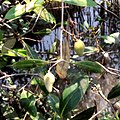Mangrove
Mangroves are a group of trees and shrubs that live in the coastal intertidal zone. There are about 80 different species of mangrove trees. All of these trees grow in areas with low-oxygen soil, where slow-moving waters allow fine sediments to accumulate.
Biology[edit]
Mangrove trees are able to absorb much higher amounts of salt than typical trees. They are able to do this through a filtration system that is in their roots. The roots also take in oxygen from the air, as the soil they grow in is often depleted of oxygen.
Distribution[edit]
Mangroves are found in the tropics and subtropics, mainly between latitudes 25° N and 25° S. The total mangrove forest area of the world in 2000 was 137,800 square kilometers (53,200 sq mi), spanning 118 countries and territories.
Ecological importance[edit]
Mangroves play a crucial role in maintaining the health of coastal ecosystems. They provide habitat for a wide range of species, including birds, mammals, and fish. In addition, they help to protect coastlines from erosion and storm surges.
Threats[edit]
Mangroves are under threat from a variety of factors, including deforestation, pollution, and climate change. These threats have led to significant declines in mangrove populations in many parts of the world.
Conservation[edit]
Efforts are being made to conserve and restore mangrove forests. These efforts include the establishment of protected areas, the implementation of sustainable forestry practices, and the promotion of community-based conservation initiatives.
See also[edit]
References[edit]
<references />
|
|
|
-
Sonneratia alba - Manado
-
Mangrove roots at low tide
-
Mangroves in Kannur, India
-
Mangrove
-
Salt crystals on Avicennia marina var resinifera leaves
-
Pneumatophore overkill - grey mangrove
-
Plody mangrovnika (Rhizophora mangle)
-
Water filtration in mangrove roots
-
One week old Mangrove, Qatif, Saudi Arabia, Late August 2020
-
Nypa fruticans - Taki - North 24 Parganas
-
Avicennia alba
Ad. Transform your life with W8MD's Budget GLP-1 injections from $75


W8MD offers a medical weight loss program to lose weight in Philadelphia. Our physician-supervised medical weight loss provides:
- Weight loss injections in NYC (generic and brand names):
- Zepbound / Mounjaro, Wegovy / Ozempic, Saxenda
- Most insurances accepted or discounted self-pay rates. We will obtain insurance prior authorizations if needed.
- Generic GLP1 weight loss injections from $75 for the starting dose.
- Also offer prescription weight loss medications including Phentermine, Qsymia, Diethylpropion, Contrave etc.
NYC weight loss doctor appointmentsNYC weight loss doctor appointments
Start your NYC weight loss journey today at our NYC medical weight loss and Philadelphia medical weight loss clinics.
- Call 718-946-5500 to lose weight in NYC or for medical weight loss in Philadelphia 215-676-2334.
- Tags:NYC medical weight loss, Philadelphia lose weight Zepbound NYC, Budget GLP1 weight loss injections, Wegovy Philadelphia, Wegovy NYC, Philadelphia medical weight loss, Brookly weight loss and Wegovy NYC
|
WikiMD's Wellness Encyclopedia |
| Let Food Be Thy Medicine Medicine Thy Food - Hippocrates |
Medical Disclaimer: WikiMD is not a substitute for professional medical advice. The information on WikiMD is provided as an information resource only, may be incorrect, outdated or misleading, and is not to be used or relied on for any diagnostic or treatment purposes. Please consult your health care provider before making any healthcare decisions or for guidance about a specific medical condition. WikiMD expressly disclaims responsibility, and shall have no liability, for any damages, loss, injury, or liability whatsoever suffered as a result of your reliance on the information contained in this site. By visiting this site you agree to the foregoing terms and conditions, which may from time to time be changed or supplemented by WikiMD. If you do not agree to the foregoing terms and conditions, you should not enter or use this site. See full disclaimer.
Credits:Most images are courtesy of Wikimedia commons, and templates, categories Wikipedia, licensed under CC BY SA or similar.
Translate this page: - East Asian
中文,
日本,
한국어,
South Asian
हिन्दी,
தமிழ்,
తెలుగు,
Urdu,
ಕನ್ನಡ,
Southeast Asian
Indonesian,
Vietnamese,
Thai,
မြန်မာဘာသာ,
বাংলা
European
español,
Deutsch,
français,
Greek,
português do Brasil,
polski,
română,
русский,
Nederlands,
norsk,
svenska,
suomi,
Italian
Middle Eastern & African
عربى,
Turkish,
Persian,
Hebrew,
Afrikaans,
isiZulu,
Kiswahili,
Other
Bulgarian,
Hungarian,
Czech,
Swedish,
മലയാളം,
मराठी,
ਪੰਜਾਬੀ,
ગુજરાતી,
Portuguese,
Ukrainian














